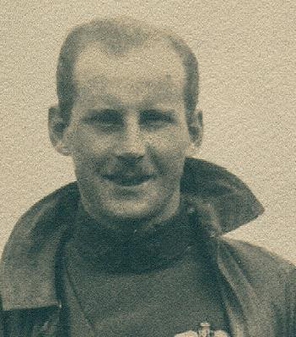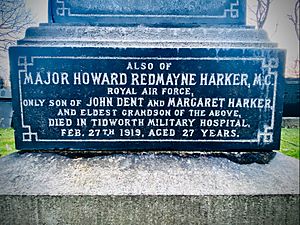Howard Harker facts for kids
Quick facts for kids
Howard Redmayne Harker
|
|
|---|---|

Major Harker c.1918
|
|
| Born | 12 May 1891 Prestwich, Lancashire, England |
| Died | 27 February 1919 (aged 27) Tidworth Barracks Hospital, Hampshire, England |
| Buried |
Southern Cemetery, Manchester, Lancashire
(53°25′45″N 2°15′32″W / 53.42917°N 2.25889°W) |
| Allegiance | United Kingdom |
| Service/ |
British Army Royal Air Force |
| Years of service | 1916–1919 |
| Rank | Major |
| Unit | No. 5 Reserve Squadron No. 57 Squadron RFC No. 2 School of Navigation and Bomb Dropping |
| Battles/wars | World War I • Western Front |
| Awards | Military Cross |
Howard Redmayne Harker was a brave British pilot during World War I. He was known as a "flying ace" because he won five air battles against enemy planes. He was born on May 12, 1891, and passed away on February 27, 1919.
Early Life and School
Howard Harker was born in a town called Prestwich in Lancashire, England. His father, John Dent Harker, was an architect. Howard went to school at Lawrence House School in St. Annes-on-Sea. He also attended Rossall School in Fleetwood. After finishing school, he went to Manchester University.
Becoming a Pilot
In 1913, Howard started working at the Royal Aircraft Factory in Farnborough, Hampshire. This was a place where airplanes were designed and built. In February 1915, he was part of an exciting event at Hendon Aerodrome. A pilot named Frank Goodden flew a new B.E.2c biplane there. He showed off some amazing flying tricks before landing.
Howard joined the Royal Flying Corps on April 15, 1916. This was the air force of Britain at the time. He started as a temporary second lieutenant. He trained at the Military Flying School in Birmingham. On May 18, he earned his pilot's license.
He was then assigned to No. 57 Squadron in France. This squadron mainly flew planes for bombing and looking for enemy positions. Howard flew an airplane called the F.E.2d. On March 24, 1917, he won his first air battle. He forced an enemy Albatros D.II plane to go down near Lens.
Howard was promoted to flight commander on April 6. This meant he was in charge of a group of planes. In May, his squadron received new planes called the DH.4. On June 18, he destroyed an enemy Albatros D.III plane south of Houthulst. He was promoted again to lieutenant on July 1, 1917.
He achieved three more victories against Albatros D.V planes. These wins happened on July 17 over Roulers, on July 28 over Ingelmunster, and on August 21 over Ledeghem–Menin.
On September 26, 1917, Howard was given a special award called the Military Cross. This award is for bravery in battle. The official announcement of his award was made on January 8, 1918. His award citation said:
"For his outstanding bravery and dedication to duty. For almost a year, he did very important work. He took airplane photos and led bombing missions far behind enemy lines. He often did this even when there was strong enemy resistance and bad weather. One time, he was coming back from a successful bombing mission. His group of planes was attacked by more than twice as many enemy planes. But because of his strong fighting spirit and great leadership, the enemy planes were scattered. He always set a wonderful example for his fellow officers."
Howard was promoted to acting-major on October 1, 1918. His last job was at the No. 2 School of Navigation and Bomb Dropping. This school was located at RAF Andover in Wiltshire.
His Passing
Howard Harker sadly passed away on February 27, 1919. He died from pneumonia at the Officers' Military Hospital in Tidworth. He is buried in the Southern Cemetery, Manchester.


